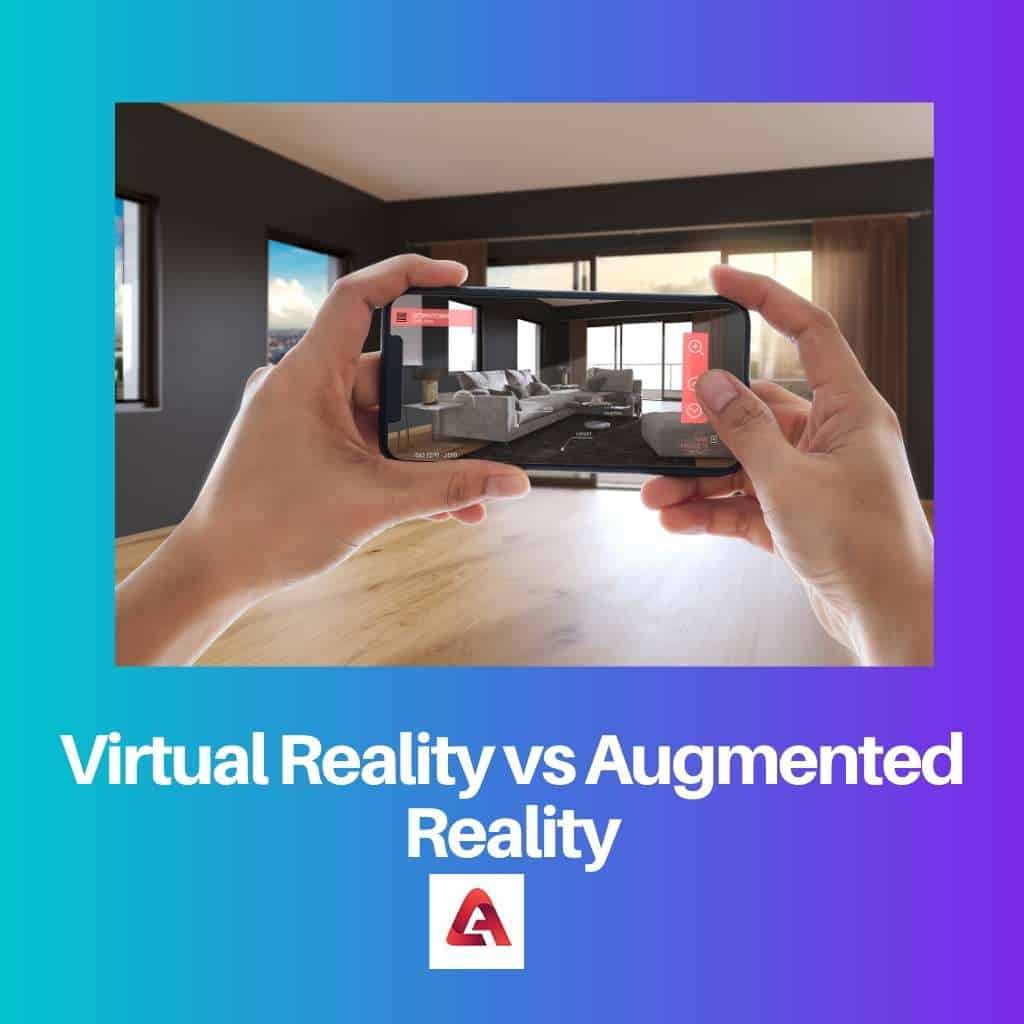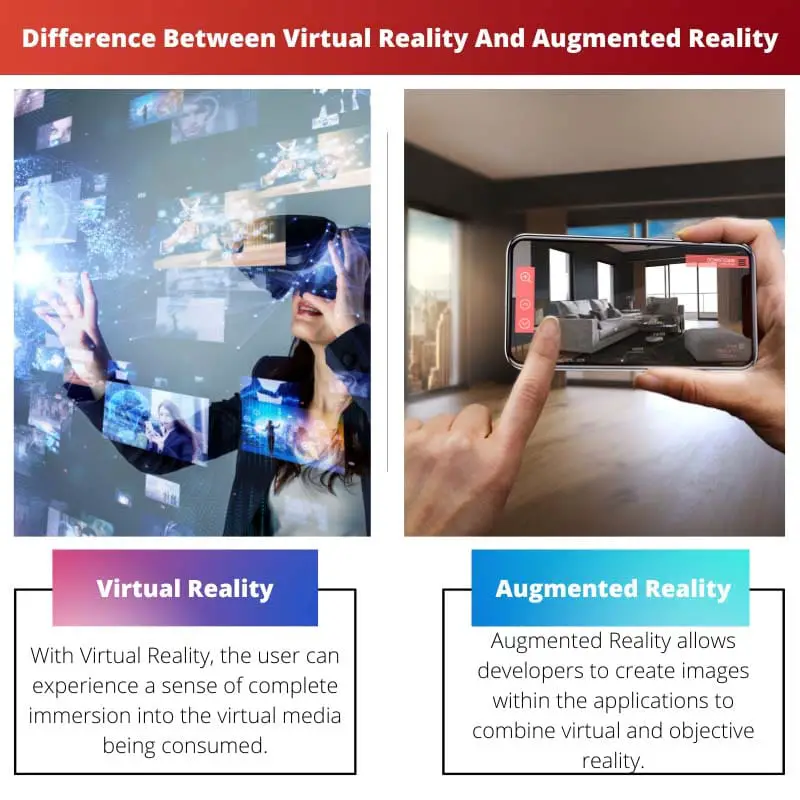Virtual Reality and Augmented Reality, abbreviated as VR and AR, respectively, are some of the most recent pieces of evidence of humanity’s technological advancement.
They share many similarities, which might make it confusing to distinguish one from the other.
The notable difference between them is that Virtual Reality puts the user in the virtual world, and Augmented Reality puts the virtual elements in the real world.
Key Takeaways
- Virtual reality immerses users in a completely digital environment, whereas augmented reality overlays digital content in the real world.
- Virtual reality requires specialized headsets, while augmented reality can be experienced with smartphones, tablets, or glasses.
- Virtual reality is popular in gaming and simulations, while augmented reality finds applications in various industries, including retail, healthcare, and education.
Virtual Reality vs Augmented Reality
The difference between Virtual reality and augmented reality is Virtual reality is fully virtual, while augmented reality is mixed with virtuality and reality. Two varieties of computer-generated simulation technologies are Virtual Reality (VR) and Augmented Reality (AR). They require 3-D content which can be viewed through a headset to stimulate a feeling of next-level immersion, whether partial or complete and enrich the overall consumer experience, mainly focusing on the visual and auditory perceptions.

With Virtual Reality, the user can experience a sense of complete immersion into the virtual media being consumed. VR enables the user to cut off from their physical surroundings completely.
This means that one can interact with the digital content and browse and navigate the simulated virtual world as one would in the real one.
Augmented Reality is a technology that allows developers to create images within the applications to combine virtual reality and objective reality.
It overlays three-dimensional virtual elements onto the environment or scenes of the physical world to create an augmented experience.
The infamous game Pokemon Go is a notable and mention-worthy example of AR.
Comparison Table
| Parameters Of Comparison | Virtual Reality | Augmented Reality |
|---|---|---|
| Definition | Wholly virtual. | Virtual mixed with real. |
| Setting | No real-world elements are utilized. VR creates a completely virtual setting of its own. | AR uses the real-world setting and enhances it with virtual elements. |
| Immersion Level | VR enables complete immersion. | AR enables partial immersion only. |
| Accessibility | VR is not readily accessible since it needs a specific device. | AR is easily accessible to users of smartphones. |
| Mobility | VR restricts the mobility of the user. | AR poses no hurdle to the user’s mobility in the real world. |
| Risk of accidents | Higher chances of accidents. | Lower risk of accidents. |
What is Virtual Reality?
For years, software developers have tried to replicate reality, and Virtual Reality (VR) is the fruit of their labor. They have managed to redevelop computer images and videos in such a manner as to create a visual phenomenon that goes beyond anything that can be achieved with even the most advanced of the regular display output devices like computer monitors, televisions, and phones.
By using computer vision and cutting-edge graphics, developers add visual depth to ordinary videos and images and scale and reconstruct the distance between two-dimensional images to generate three-dimensional content.
Gaming and entertainment are the most apparent fields of application of VR. But the medical field is probably the utmost beneficial application of it, especially in treating psychological and neurological disorders.
VR enables efficient execution of exposure therapy where doctors can study patients’ reactions in different situations and treat their problems accordingly.
Treatment of issues like PTSD, Autism, Anxiety disorders, and even seemingly incurable conditions like Paraplegia has advanced by leaps and bounds owing to VR technology.
VR also allows the training of soldiers without directly exposing them to dangerous situations. Other applications of VR include business forecasting, where new designs and models of products such as cars can be introduced to partners and investors to examine beforehand.

What is Augmented Reality?
AR is about enhancing the environment of the objective reality of the user, using digital animations and such, unlike VR, which attempts to recreate and replace it.
The combined image produced after overlaying virtual elements on real ones is projected on the mobile screen, AR glasses, etc. AR glasses partially immersive experience.
The user can see his surroundings through the lenses and add virtual objects.
For example, a person can draw markers to mark certain areas of whatever they are viewing through the lens. Therefore they can see their environment and enrich it.
Once again, even in the case of AR, the most evident and widespread application is in gaming and entertainment. But retail is an exciting beneficiary of AR.
With this technology, customers can make wiser investment decisions by virtually placing objects like furniture in their intended positions.
Real estate agents can offer to conduct virtual walk-throughs of spaces so that clients can remotely make real estate decisions. Apart from this, healthcare workers can monitor and diagnose patients remotely.
In the case of maintenance, professionals can oversee repair work without having to travel to the locations, especially if they are inaccessible.
The tourism industry has also benefited from AR tech.

Main Differences Between Virtual Reality and Augmented Reality
- VR is a hundred per cent computer-generated experience where the viewer can interact with the virtual world. AR is a blend of virtual objects in the physical world.
- The VR experience does not utilize any component of objective reality; therefore, the setting is entirely virtual. AR incorporates all the elements of the physical surroundings of the consumer into the experience. So it is set in reality.
- In the case of VR, the level of immersion is complete. The viewer is entirely cut off from the real world. The same is not true for AR. AR offers only a partial level of immersion.
- Even though both technologies are almost equally expensive, VR is harder to access than AR because VR content has to be specially made, which makes it sparse.
- A person using a VR device has to remain static in the real physical world because their visual and sometimes auditory connection to their surroundings is cut off while using the device. On the other hand, AR doesn’t hinder the user’s mobility because it integrates their surroundings into the overall experience.
- Since VR cuts off the user to the world, the risks of accidents increase significantly. AR users remain alert to their surroundings, so the risks are considerably lower.

- https://www.tandfonline.com/doi/abs/10.1080/07421222.2019.1628877
- https://www.sciencedirect.com/science/article/abs/pii/S1286011520300813
